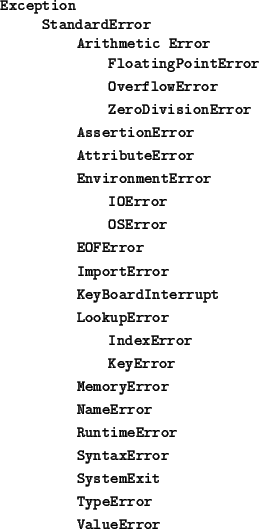



Next: Raising Exceptions
Up: Exceptions
Previous: Dealing with Multiple Exceptions
Contents
When you have several except clauses as part of a try/except construct,
and an exception is raised,
the statements after the first except clause which is matched will be executed.
Usually this will not cause any surprises, but there is a hierarchy of exceptions in Python
so that exceptions higher in the hierarchy will be activated even though they are not an
exact match for
the exception that has been raised. For example, the EnvironmentError exception
will catch both IOErrors and OSErrors. Thus, when you create
try/except clauses in your programs, the ordering of the exceptions may affect they
way that their corresponding code is called. Continuing with the EnvironmentError
example,
if an except clause for an OSError appeared after an except clause
for an EnvironmentError within the same try/except construction, the
OSError clause would never be activated, since the EnvironmentError would
intercept the exception, and only one exception per try/except construct will ever
be activated. On the other hand, if the EnvironmentError clause appeared after the
OSError clause, it would be activated when an IOError was raised, since
that exception is below EnvironmentError in the exception hierarchy.
Figure 9.1 illustrates the hierarchy; exceptions which are indented below other
exceptions will be caught by the less indented exception as well as through their own names.
Figure 9.1:
Exception Hierarchy
 |




Next: Raising Exceptions
Up: Exceptions
Previous: Dealing with Multiple Exceptions
Contents
Phil Spector
2003-11-12
